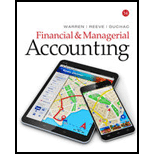
Concept explainers
Bad debt expense:
Bad debt expense is an expense account. The amounts of loss incurred from extending credit to the customers are recorded as bad debt expense. In other words, the estimated uncollectible accounts receivable are known as bad debt expense.
Direct write-off method:
This method does not make allowance or estimation for uncollectible accounts, instead this method directly write-off the actual uncollectible accounts by debiting bad debt expense and by crediting accounts receivable. Under this method, accounts would be written off only when the receivables from a customer remain uncollectible.
Allowance method:
It is a method for accounting bad debt expense, where amount of uncollectible accounts receivables are estimated and recorded at the end of particular period. Under this method,
To determine: The amount of net income would have been, if Company MPS estimated that 1% of sales would be uncollectible, instead of using direct write off method.
Want to see the full answer?
Check out a sample textbook solution
Chapter 8 Solutions
Financial & Managerial Accounting, Loose-Leaf Version
- The per-unit standards for direct labor are 1.8 direct labor hours at $16 per hour. If, in producing 1,500 units, the actual direct labor cost was $42,500 for 2,600 direct labor hours worked, what is the total direct labor variance?arrow_forwardHello tutor solve this question and accounting questionarrow_forwardWhat is the level of its accounts receivable? accounting questionarrow_forward
- Gadot Industries developed the following per-unitstandards for its product: 7 pounds of direct materials at $4.85 per pound. Last month, 52,000 pounds of direct materials were purchased for $247,000, and 49,000 pounds were used in production. What is the direct materials price variance? A. $7,800 favourable B. $6,500 unfavourable C. $6,450 favourable D. $7,150 unfavourablearrow_forwardWhat is the direct labor price variance for September ?arrow_forwardWhat is the unit cost for the brewing department before transferring the units to the bottling department?arrow_forward
- White Co. incurs a cost of $17 per pound to produce Product X, which it sells for $25 per pound. The company can further process Product X to produce Product Y. Product Y would sell for $31 per pound and would require an additional cost of $15 per pound to be produced. The differential cost of producing Product Y is: a. $15 per pound b. $26 per pound c. $13 per pound d. $10 per poundarrow_forwardSummit Corp. produces 145 snowmobiles per month. Direct costs are $2,720 per snowmobile. The monthly overhead is $95,000. What is the average cost per snowmobile with overhead?arrow_forwardexpert of accounting questionarrow_forward
- ABC Manufacturing's cost is $7,200 at 800 units, $11,500 at 1,600 units, and $14,300 at 2,400 units. This cost is a __. A. step cost. B. fixed cost. C. mixed cost. D. variable cost.arrow_forwardI need the correct answer to this financial accounting problem using the standard accounting approach.arrow_forwardWhat is the level of its accounts receivable?arrow_forward
 Cornerstones of Financial AccountingAccountingISBN:9781337690881Author:Jay Rich, Jeff JonesPublisher:Cengage Learning
Cornerstones of Financial AccountingAccountingISBN:9781337690881Author:Jay Rich, Jeff JonesPublisher:Cengage Learning College Accounting, Chapters 1-27AccountingISBN:9781337794756Author:HEINTZ, James A.Publisher:Cengage Learning,Principles of Accounting Volume 1AccountingISBN:9781947172685Author:OpenStaxPublisher:OpenStax College
College Accounting, Chapters 1-27AccountingISBN:9781337794756Author:HEINTZ, James A.Publisher:Cengage Learning,Principles of Accounting Volume 1AccountingISBN:9781947172685Author:OpenStaxPublisher:OpenStax College Financial AccountingAccountingISBN:9781337272124Author:Carl Warren, James M. Reeve, Jonathan DuchacPublisher:Cengage Learning
Financial AccountingAccountingISBN:9781337272124Author:Carl Warren, James M. Reeve, Jonathan DuchacPublisher:Cengage Learning




